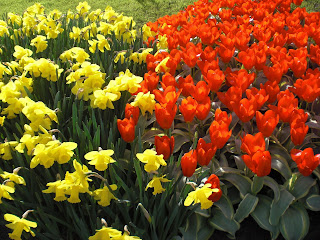 Our first stop was Eethen, a small village in south east Holland, where Arendje was born. We didn`t stop long but went on the Genderen, a small village where the Walraven`s had a farm and sold feed to other farmers for their animals. The farm house is still there although it is hard to recognize because it has been painted white; it hasn`t been lived in for 34 years but is used as a business. Genderen is a very small village - immaculately clean and picturesque.
Our first stop was Eethen, a small village in south east Holland, where Arendje was born. We didn`t stop long but went on the Genderen, a small village where the Walraven`s had a farm and sold feed to other farmers for their animals. The farm house is still there although it is hard to recognize because it has been painted white; it hasn`t been lived in for 34 years but is used as a business. Genderen is a very small village - immaculately clean and picturesque.

The house used to be a brown brick but is now white and the windows are much bigger than they used to be.
Next we were on to Rotterdam to pick up our `Holland Pass` - tickets we bought for the events we wanted to see. We were too late to take a harbour cruise so we drove to Kinderdijk. Here we see 19 old windmills built in the 1740`s to drain the water off the farm land. The windmills are still standing although not used for the same purpose - except for 2 which have been mechanized. Very authentic!


We spent the night at Alan Jenks and Jen Walraven`s house. She was very gracious and we enjoyed visiting with her and her husband and meeting their cute little red-haired girl Kylee. Kylee is 17 months old and she was born in Holland. They came to Holland to set up a chiropractic practice. The visit made me homesick for my grandkids.
 Early Saturday morning we were on the way to Keukenhof to see the flower gardens. We managed to beat most of the crowds and even the men thought the stop was worthwhile. By the time we left at around 11:00, the people were starting to be wall-to-wall and as we drove away, we passed at least 5 miles of traffic trying to get to the site - many, many tour buses and private vehicles full of people on their way to see the tulips, daffodils and hyacinths.
Early Saturday morning we were on the way to Keukenhof to see the flower gardens. We managed to beat most of the crowds and even the men thought the stop was worthwhile. By the time we left at around 11:00, the people were starting to be wall-to-wall and as we drove away, we passed at least 5 miles of traffic trying to get to the site - many, many tour buses and private vehicles full of people on their way to see the tulips, daffodils and hyacinths.The gardens plant more than 7 million bulbs every year, is open for 2 months and is the most photographed garden in the world. These are some of the pictures we were able to take:


 We drove to Amsterdam next - although we didn`t spend a lot of time there - we did do a canal cruise around the harbor viewing the 17th century buildings which were mostly warehouses but have been converted to condos - very narrow but high. Most have a pulley system hanging from the top floor to move furniture in and out since the stairs are too narrow.
We drove to Amsterdam next - although we didn`t spend a lot of time there - we did do a canal cruise around the harbor viewing the 17th century buildings which were mostly warehouses but have been converted to condos - very narrow but high. Most have a pulley system hanging from the top floor to move furniture in and out since the stairs are too narrow. 
We also toured the Rijks Museum which holds many masters pieces by Rembrandt and Reuben. The museum is just the right size - two floor - and it is easy to enjoy the magnificent pieces hanging there.








